Resources
Horse Fence Comparison
Use these fence comparisons to find a system that best suits the needs of you and your horse. The costs listed are for fence options only. They DO NOT include posts, hardware, or accessories. When calculating costs, keep in mind the number of lines or rails you will use. For example, Hotcote wire is just $0.125 per foot, but if you are using five line wires, the actual cost will be $0.625 per foot.
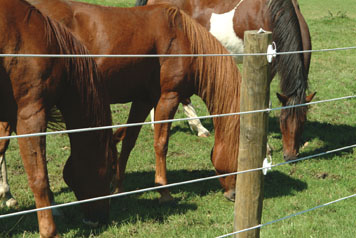
|
Kencote Coated Wire
Compared to standard high-tensile fence wire, this 12½ gauge, plastic-coated wire is more attractive, safer, and more visible. This wire costs about $0.125 per foot ($0.625 per foot for five lines), and it can be installed with up to 15’ post spacing when electric wire is also used on the fence. Kencote’s high-tensile core has a Class 3 galvanized zinc coating for 30-60 year life expectancy.
|

|
Hotcote Electrified Coated Wire
Hotcote adds electric, visibility, safety, and good looks to any fence. It is made with our high-strength, 210 KSI, Class 3 galvanized, 12½ gauge wire as the core. Overall thickness is about 0.3”, making it the most visible coated wire on the market. The lifetime of coated wire products is increased by adding electric. Electric keeps animals from working against the fence and wearing the plastic at points of attachment. At $0.13 per foot, this highly visible wire is a safer alternative to smooth, high-tensile wire. |
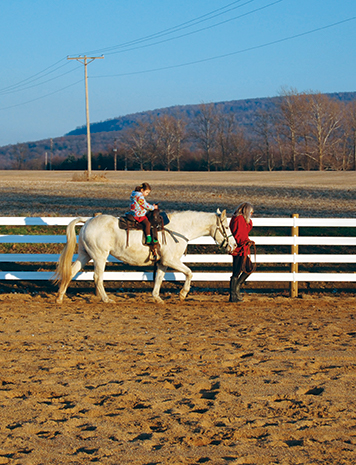
|
Horserail 4", 5", or 6"
Horserail has a beautiful wooden board look with a 20-year life expectancy and no need for paint. The rail is composed of UV-stabilized, premium-grade polyethylene that is molecularly bonded to prestraightened, galvanized, 180 KSI, 12½ gauge high-tensile wire. It is safer than wood because it flexes rather than breaking on impact. It has a lower risk of injury than wire as it is hard to get caught or cut with the smooth, wide, plastic rails. Post spacing of up to 12’ is common. Each rail has over 3,000 pounds of breaking strength and is backed by a 30-year limited replacement warranty. This rail requires well-braced ends, which take time to build properly, particularly if you don’t have a hydraulic post driver. Cost is about $0.56 to $0.75 per foot ($1.68 to $2.25 per foot for three rails). Horserail is available in white, black, and brown and in widths of 4”, 5”, and 6”. The 4” rail has two wires (top and bottom), and the 5” and 6” rail has 3 wires (top, bottom, and center). The flexibility, smoothness, and strength of this rail not only protects the horse and rider from injuries caused by conventional railing, but also provides a long-lasting, attractive rail that requires little maintenance. |

|
HotTop Plus – 4¼” or 5¼”
Made with the same flexible polyethylene and high-tensile wire as Horserail, but with the added benefit of electrification. The signature spark of HotTop Plus is made possible by strips of highly conductive carbon running along the top and bottom wires. When partnered with a high-quality, low-impedance energizer, it creates an electrified physical and psychological barrier. Self-preservation is an important feature of HotTop Plus. The electrification discourages horses from cribbing or reach-through behaviors, minimizing the abuse the fence will take and thus extending its life. While Horserail is designed to safely resist impact, the zap of HotTop Plus provides an added incentive for horses to stay off the fence. UV-resistant polyethylene resists weathering. Cost is $0.63 per foot for 4¼” to $0.88 per foot for 5¼” ($1.89 to $2.64 for three rails). |

|
Board Fence
Poplar Board Fence is ideal if you want a rustic, wood fence look. It is easy to install and repair. Drawbacks are the high costs of wood products, which make up most of the fence materials. Life expectancy is not as long as other fence types, but using an offset electric wire to prevent cribbing may extend the life. Cost can be $0.60 per foot of rail ($1.80 per foot for three rails). |
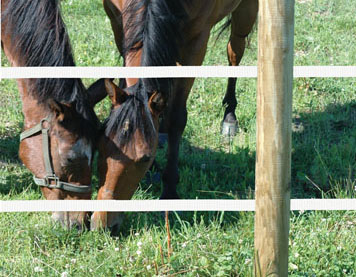
|
SAFE-FENCE
SAFE-FENCE is easier and quicker to build than many systems because there is no need for special tools. The 1½” wide electric tape is tensioned by hand. End posts do not have to be super strong. The tape is highly visible, and the potential for injury is low. The electric tape is about $0.12 per foot. Because 15 stainless-steel conductors are woven into the tape, there is no need to run other electric wires. This product comes with a five-year limited warranty. |
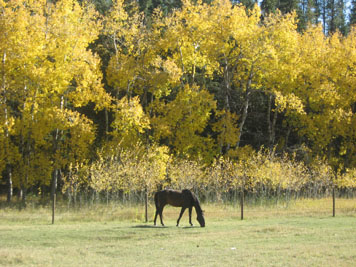
|
High-Tensile Smooth Wire
Long life, high strength, resiliency, low cost, and easy maintenance are all reasons to consider this fence. Simple electrification gives superior control of animals inside and outside the fence. However, relatively poor visibility, risk of entanglement, and risk of injury must be considered when choosing this type of fence for horses. Using closer post spacing, spacers, fence flags, and/or electric tape will improve the visibility of this product. Keeping the bottom wire higher off the ground, using fewer strands, and relying on the electricity to do the actual control will make entanglement unlikely. High-tensile wire fence can cost $0.02 to $0.03 per foot of wire ($0.12 to $0.18 per foot for the recommended six lines). |
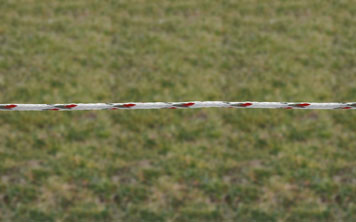
|
Electric Twine and Ribbon (Polywire)
This fence is very quick and easy to install. Visibility is good, and it is easy for an animal to break away if it becomes entangled. It is useful for intensive grazing management to get the most feed from the pasture. This system is also excellent for temporary fences on trail rides. Cost is $0.025 to $0.04 per foot of twine or tape. Electricity is a must, but do not use a high-impedance charger. Sunlight will cause this material to need to be replaced within about 10 years. |
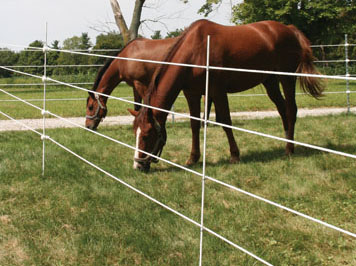
|
Electric Rope
Rope makes an electric fence that is much more visible than wire or twine. It does not require braced end posts, and it is easy to hand-knot. Round rope does not whip in the wind as much as electric ribbon, so post spacing can be wider. The higher breaking strength allows it to handle mush more abuse. Depending on thickness or conductivity, rope generally costs $0.075 to $0.09 per foot. |
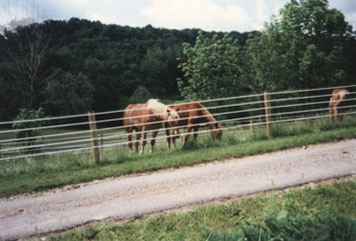
|
1" PonyRail
Excellent visibility at a much lower cost ($0.21 per foot of rail) than 4” Horserail. Little to no bracing is required since lighter gauge wire is used with lower tensions. Rolling ground is easier to fence with Ponyrail than it is with 4” Horserail, and 20’ post spacing is possible when using electric wires with the rail. The 14½ gauge, Galfan-coated wire in Ponyrail will last longer than the 12½ gauge galvanized wire in the 4” Horserail. |
The following is a material list to do the same 15 acre pasture with Safe Fence. Tightening is more difficult since it is done by hand pulling the ribbon through the stainless steel buckles. The gate handle is attached to the ribbon by using one of the buckles from the T-style Buckles + Insulator.
Step 1 – Install Fence Posts
After careful consideration and planning, start by installing end and corner posts which should be a minimum 5" diameter and set 3 ft to 4 ft in the ground. These posts can be either concreted (allow concrete to cure before tensioning) or firmly tamped. Round posts are stronger and less likely to warp than square posts.
Step 2 – Install Corner Insulators
Attach lag screws (ILCW) to end posts, and use Corner Collar insulators (ICPW) on corner posts. Attach and pay out one strand of rope (RO4) as a guide. You can use this guide for placement of line posts, which are typically spaced 10 to 15 ft. apart. The number of strands and spacing you use depends on your livestock and conditions. The most common rope fence Kencove sells is four strands. The rope can be run as one continuous length or cut and spliced at every end.
Step 3 – Install Line Post Insulators
Using spacing from the ground up 20" 10" 10" 10" gives a 50" high fence. Attaching insulators to the line posts is part science, part art. After marking each post, but before permanently attaching insulators, step back and adjust out peaks or valleys. This will enhance the smooth flow of your rope fence. Pull all strands tight and secure with a Rope Clamp (CWBT). Final tensioning can be done with an online tensioner (SSDR).
Step 4 – Electrify the Fence Line
Install a low-impedance energizer. To insure continuity of the electric pulse individual ropes must be connected. Leftover rope can be used, or a Kencove rope to rope electric jumper (CRR) will insure good continuity.







